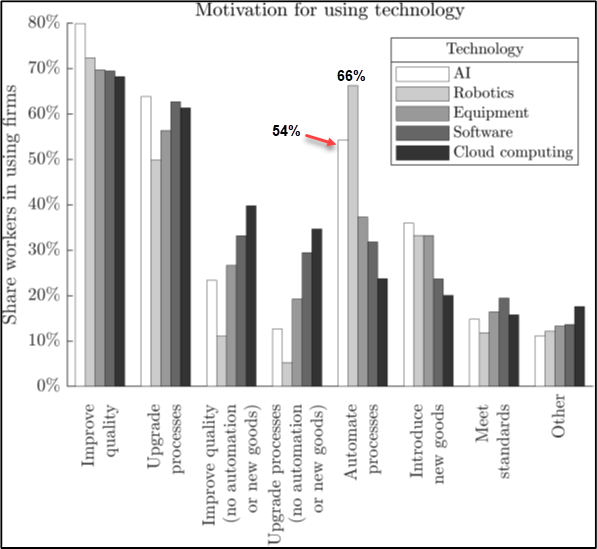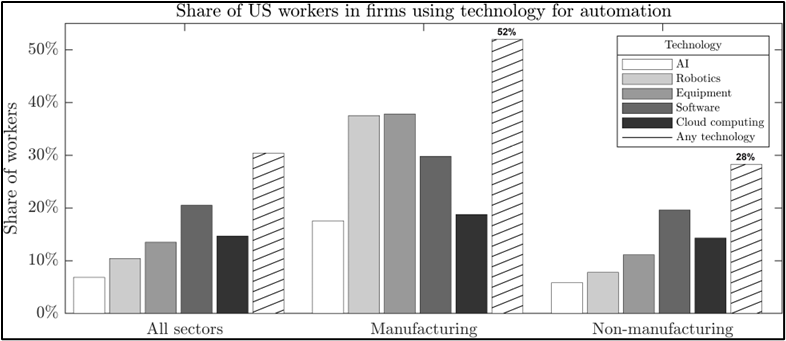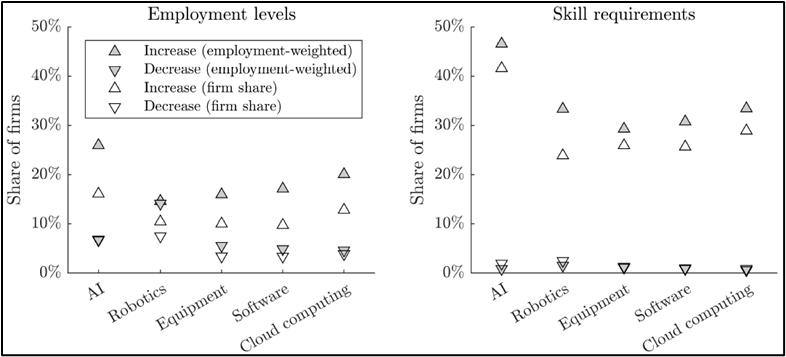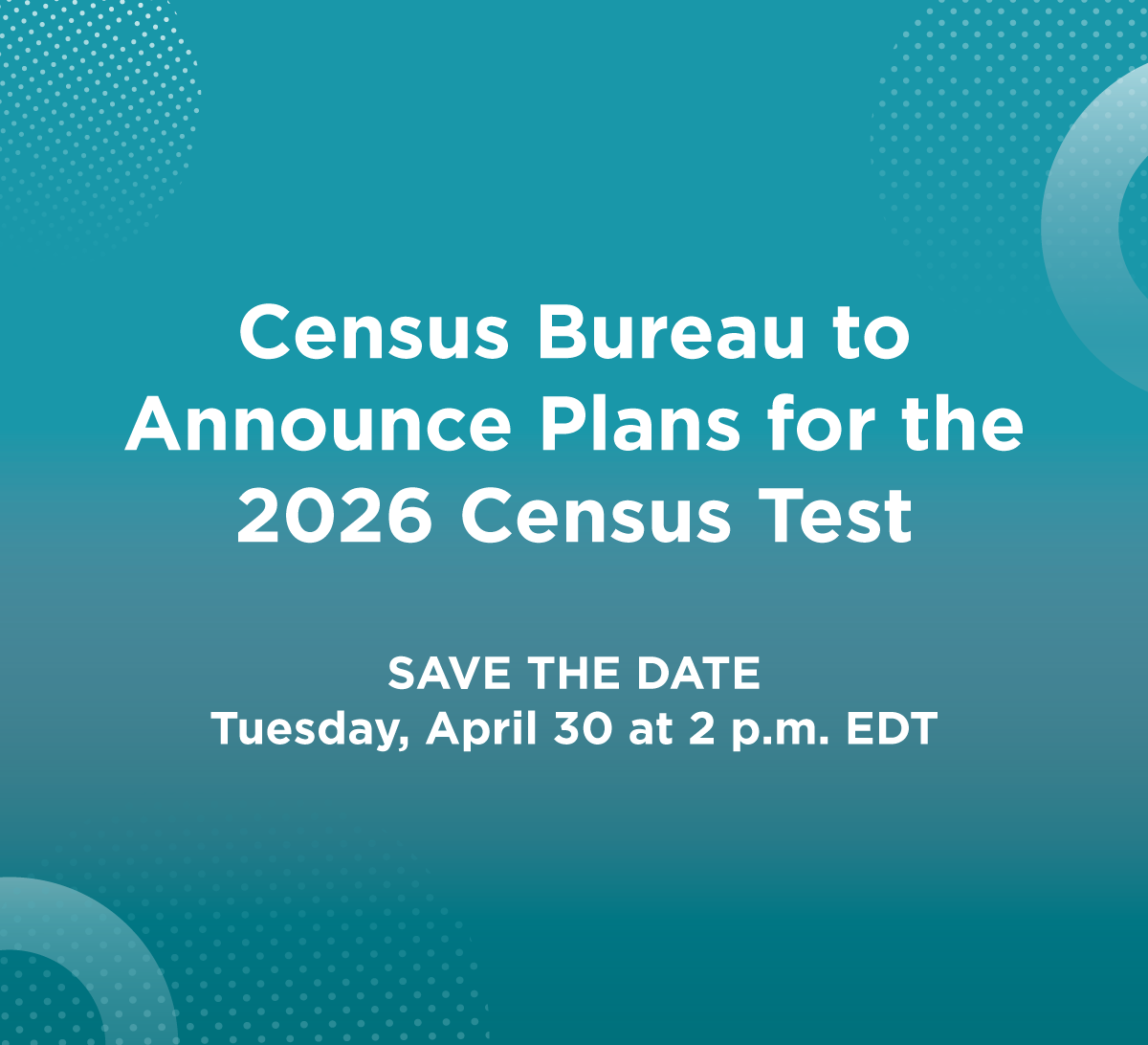Three Results From Recent Research on Advanced Technology Use and Automation
Using robots to automate tasks is becoming increasingly common, even outside of manufacturing — for example, in fast food restaurant kitchens and hospitals. Similarly, recent advances in artificial intelligence (AI) suggest that AI is increasingly able to perform tasks (e.g., compose music, write poetry, and generate images) until recently believed to be reserved for humans. In general, the diffusion of advanced technologies like robotics and AI is accompanied by questions about whether they will mainly augment workers’ skills or substitute for them.
In this blog, we describe research1 on advanced technologies (defined in Box 1) and their potential effects on employment using new firm-level data on technology adoption collected in the 2019 Annual Business Survey (ABS) by the Census Bureau in partnership with the National Center for Science and Engineering Statistics of the National Science Foundation.2 Among many other findings, this research shows:
Box 1: Definitions of Technologies Surveyed in the 2019 ABS
- Artificial intelligence. Making machines intelligent., Able to perceive, analyze, determine response, and act appropriately in their environment.
- Robots. Reprogrammable, multipurpose machines capable of automatically carrying out a complex set of actions.
- Specialized software (excluding AI). Software dedicated to performing a particular business function.
- Dedicated equipment (excluding robots). Equipment capable of automatically carrying out a prespecified task.
- Cloud-based computing systems and applications. Computing resources available on-demand via the internet.
Source: U.S. Census Bureau, 2019 Annual Business Survey (ABS) questionnaire (abridged).
- Automation of tasks performed by labor is a more common motivator for firms adopting AI and robots than other advanced technologies (Figure 1).
- Around 30% of all workers are potentially exposed to advanced technologies used for automation purposes, with manufacturing workers much more exposed than other workers (Figure 2).
- Demand for worker skills appears to be much more positively affected by technology use than overall employment levels, but those effects vary by technology, with ambiguous employment effects of robot use and more positive employment effects for AI (Figure 3).
Figure 1. Compared to Other Technologies, AI and Robotics Adoption is More Motivated by Automation

Source: Acemoglu, et al., 2022 (using ABS data for 2016-2018). Estimates shown represent employment at technology adopting firms that cite each motivation divided by total employment at technology adopting firms.3
We start by looking at why firms adopt advanced technologies. Figure 1 shows the share of workers at technology-using firms by adoption motivation. Improving the quality of production processes is the most common motivation reported by firms accounting for 68% to 80% of workers at technology using firms. As compared to other technologies, AI and robots have the highest share citing automation as a motivation (applicable to technology-using firms that account for 54% and 66% of workers, respectively). Since technology-using firms can choose more than one motivation, the shares of workers at firms that reported improving quality and upgrading methods but not automation or the introduction of new goods are shown separately; technologies other than AI and robotics are more apt to cite these motivations.
Figure 2. Manufacturing Workers are More Exposed to Advanced Technologies for Automation Than Other Workers

Source: Acemoglu, et al., 2022. Exposure is the number of workers at firms using each technology for automation divided by the total number of workers, using ABS data for 2016-2018. Exposure provides an upper-bound measure of the extent of automation in U.S. labor markets. Footnote 3 in this blog provides the exact wording of the question in the Annual Business Survey.
We next turn to broad measures of how many workers are exposed to advanced technologies. Figure 2 shows the shares of workers in firms that adopted advanced technologies to automate production tasks. Note that Figure 2 reports “potential exposure” of workers to advanced automating technologies; exposures should be interpreted as upper bounds to the actual share of workers potentially affected by advanced technology adoption and use. In the manufacturing sector there is more exposure to any automating technologies than in the rest of the economy (52% of workers compared to 28%). AI and robots are associated with much more worker automation exposure in manufacturing than in nonmanufacturing, in part because robots are more widely adopted in manufacturing than in other sectors, and manufacturing is among the sectors with the highest AI adoption rates. However, it is noteworthy that worker exposure to automation is about the same in manufacturing firms using dedicated (nonrobotic) equipment as it is in manufacturers using robots. Furthermore, dedicated (nonrobotic) equipment, specialized software (other than AI), and cloud computing are also associated with much greater worker automation exposure in manufacturing than they are in nonmanufacturing. Next, we turn to how technology affects demand for workers.
Figure 3. Technology Use Is More Associated With Changes in Skill Requirements Than in Employment

Source: Acemoglu, et al., 2022 (using the ABS data for 2016-2018.)4 Triangles with darker outlines are cases where firm shares (sample-weighted and employment-weighted) coincide.
Figure 3 shows the self-reported impact of advanced technology adoption on firm-level demand for workers and skills. The shares of workers at technology-using firms that attribute decreases in employment to technology adoption are generally outweighed by the shares of workers at such firms reporting increases; and 67% to 78% of firms report no change in employment due to technology adoption (this is the difference between 100% and the shares denoted by the triangles in the figure). AI-using firms are more likely than other technology users to report increases in employment due to the technology. In contrast, the share of firms reporting negative effects of robot use on employment is nearly the same as the share reporting positive effects. In terms of skill requirements, the share of workers at firms reporting that technology adoption increased demand for skills far outweighs shares of workers at such firms reporting a decrease in demand for skills; this finding is especially true for AI-using firms. However, respondents may be averse to reporting employment reductions even in a confidential survey. Note also that we do not have quantitative measures of the extent of employment change because of using a given technology. We measure only the direction of change at the firm level.
This research shows that while the potential exposure of workers to automation technologies is large, the reported direction of change in employment levels of firms using technologies for automation is generally more positive than negative (except for robotics), while the reported direction of impact on skills is overwhelmingly positive, suggesting that technology-using firms increase their demand for skilled labor. However, the paper that is the basis for this blog also shows that adoption of advanced technologies is associated with higher labor productivity. Thus, the impact on employment in nonadopting competitors — through reallocation of production to higher-productivity adopters — may be large enough to cause negative and significant longer-term impacts of advanced technology use on overall employment. Further research is needed to assess this possibility.
Finally, given the recent acceleration in AI advances, the Census Bureau will add questions to the newly expanded biweekly Business Trends and Outlook Survey (BTOS). Starting Dec. 4, 2023 (for one cycle), BTOS will collect near real-time information about firms’ current and prospective uses of AI and their implications for automation.
1 Acemoglu, Daron, Gary Anderson, David Beede, Catherine Buffington, Eric Childress, Emin Dinlersoz, Lucia Foster, Nathan Goldschlag, John Haltiwanger, Zachary Kroff, Pascual Restrepo, and Nikolas Zolas, 2022, "Automation and the Workforce: A Firm-Level View from the 2019 Annual Business Survey," Working Paper 22-12, Center for Economic Studies, U.S. Census Bureau.
2 The Annual Business Survey (ABS) consolidates several surveys: the five-year Survey of Business Owners (SBO) for employer businesses, the Annual Survey of Entrepreneurs (ASE), the Business R&D and Innovation for Microbusinesses survey (BRDI-M), and the innovation section of the Business R&D and Innovation Survey (BRDI-S). The ABS is one of the few sources of data on economic and demographic characteristics for businesses and business owners by sex, ethnicity, race and veteran status. The ABS is also one of the few sources of microdata on topics such as firms’ innovation and technology activities.
3 The ABS asked, “Motivation for [advanced technology] Adoption and Utilization – Processes and Methods: During the three years 2016 to 2018, why did this business adopt or use [advanced technology]? Select all that apply: To automate tasks performed by labor; To upgrade outdated processes or methods; To improve quality or reliability of processes or methods; To expand the range of goods or services; To adopt standards and accreditation; Some other reason.”
4 The ABS asks respondents to report whether the effects of adopting advanced technologies led to increases in workers and worker skill levels: “During the three years 2016 to 2018, what were the effects of adopting or using [specific advanced technology] on the following? A. The number of workers employed by this business increased, decreased, or did not change. B. The skill level of workers employed by this business increased overall, decreased overall, or did not change overall. C. The scientific, technological, engineering, and mathematical skills of workers employed by this business increased overall, decreased overall, did not change overall, or not applicable, we did not employ workers with scientific, technological, engineering, and mathematical skills.”






